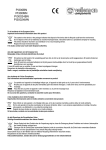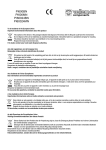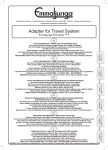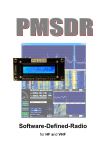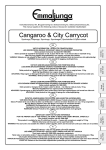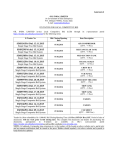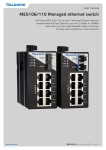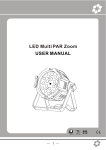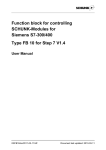Download Installation Manual
Transcript
Installation Manual PellX 20 kW Pellets Burner Gordic Environment AB P.O Box 11, SE 280 22 Vittsjö, Sweden 1 INFORMATION ...................................................................................................................2 1.1 INTRODUCTION ..................................................................................................................2 1.2 TECHNICAL DATA. DIMENSIONS ........................................................................................3 1.3 DELIVERY CHECK ..............................................................................................................4 2 INSTALLATION ..................................................................................................................5 2.1 PRECAUTIONS ....................................................................................................................5 Boiler ..................................................................................................................................6 Chimney ..............................................................................................................................6 2.2 MOUNTING ........................................................................................................................8 General ...............................................................................................................................8 Burner installation..............................................................................................................9 Pellet storage......................................................................................................................9 Feed screw installation.....................................................................................................10 Installation of the control box ..........................................................................................11 Connection of temperature sensor....................................................................................13 Draft regulator .................................................................................................................14 2.3 ELECTRICAL INSTALLATION .............................................................................................15 Mains supply.....................................................................................................................15 Connections inside the burner..........................................................................................16 2.4 SETTINGS .........................................................................................................................17 Control box functions .......................................................................................................17 Description. Control box adjustments ..............................................................................18 First start/adjustment during operation ...........................................................................20 Modifications/Adaptions...................................................................................................22 Eng. Edition 1.0 2004, Nov. 1 1 Information 1.1 Introduction This installation manual is a supplement to the Operation and Maintenance Manual, which is supplied with the PellX burner. The manual presumes general knowledge regarding installation of pellets burners and boilers, which are suitable for being fitted with a pellets burner. In case that you are not acquainted with the burner or if there are any other unclear questions, please contact the authorized PellX dealer for more detailed information. This burner is different from earlier versions. The electronic control system is completely new and the design is improved in many other respects. To get to know the function of the burner, we recommend you to study the Operation and Maintenance Manual carefully. Used symbols Warnings and safety regulations This sign is used to draw your attention to instructions especially important from the safety point of view. Non-compliance may cause serious damage to the equipment and be a risk to yourself and the safety of other people. 2 Eng. Edition 1.0 2004, Nov. 1.2 Technical data. Dimensions Heat output, max. ___________________ Heat output, min. ___________________ Output levels ___________________ Combustion efficiency ___________ Combustion air consumption ___________ Weight ___________________________ Power supply _________________ Power consumption (ignition)__________ Power consumption (operation)_________ Fuel ___________________________ Dimensions (outside the boiler): Depth __________________________ Width _________________________ Total height ______________________ approx. 20 kW approx. 13 kW 65 %, 100 % approx. 95 % approx. 30 – 40 m3/h approx. 13 kg 230 V 50 Hz 400 W 40 W Wood pellets: ∅ 6 or ∅ 8 mm max. length 30 mm 300 mm 225 mm 520 mm Dimensions, combustion chamber tube in the boiler: Length _________________________ 205 mm Diameter _______________________ 155 mm Recommended exhaust gas values: CO2 ___________________________ CO ___________________________ 10 – 13 % < 300 ppm Recommended exhaust gas temperature _ 180 ±20ºC (Measured directly after the boiler) Eng. Edition 1.0 2004, Nov. 3 1.3 Delivery check The standard delivery includes the above shown equipment. (Sealing cord, 2 pcs. and stop screw, 1 pc. belong to the mounting flange). The following items are also included in the box: • Operation and Maintenance Manual • Short maintenance instruction (A4 poster) • • • Plastic tubing (blue pellets tubing) Hose adapter between plastic tubing and flame trap pipe Hose clamps, 2 pcs. (for the plastic tubing) • Suspendor (straps for the feed screw) • • • • Signal cable, 3 m (15-poles D-Sub cable) Mains cable, 2.5 m (for mains supply to the burner) Net cable, 2.5 m (for connection between burner and feed screw) Temperature sensor, 2 or 5 m (temp.sensor start/stop, for connection to the control box) If a PellX feed screw is included in the delivery, the motor will be packed in the box, while the tubing/screw, 1.7 or 2.3 m, is in a separate package. A flat mounting plate, 350 x 350 mm, is available as option. If ordered, it will be packed in the box. 4 Eng. Edition 1.0 2004, Nov. 2 Installation 2.1 Precautions Before selling a PellX burner, the dealer has to be sure that all conditions necessary for creating a functional installation are fulfilled. If extra modifications have to be carried out, information must be given before selling the burner. Always check the local regulations for new/changed installations with the housing committee in the municipality, where the installation is to be made. A permit might be required. Also contact the local chimney sweep. The boiler room, where the pellets burner is to be installed, the chimney and other auxiliary equipment must comply with the current fire protection regulations and local standards. The boiler room must be provided with an open air inlet valve with a free area corresponding to the chimney cross sectional area. A warm air boiler may not take warm air from the boiler room. The burner installation shall be carried out by an authorized installation contractor in accordance with the instructions in the PellX Installation Manual and according to local regulations. Electrical authorization is required for the electrical installation. Final inspection, function control and adjustment of the installation are to be carried out by a person with PellX authorization. Eng. Edition 1.0 2004, Nov. 5 Boiler Check the condition of the boiler to avoid that unexpected operational troubles will occur in the future. Exhaust valves, if any, shall be fully open. All doors and exhaust connections on the boiler shall be tight. It is important that the fire place is big enough, so that the flame will not be in contact with water-cooled walls. The burner’s capacity must conform to the size of the boiler. The fireplace, where the burner is mounted, must be dimensioned for the output of the burner. In so called combi-boilers, the fireplaces for oil and wood can be dimensioned for different maximum output. There must be enough space for the ash. The exhaust channels must be wide enough not to be easily plugged with ash. The distance between the upper edge of the pellets burner’s combustion chamber tube and the fireplace roof must be at least 50 mm. As general the distance between the front edge of the burner and the rear fireplace wall should be 300 mm, which however can often be reduced to 200 mm. The important thing is that the flames from the combustion chamber tube never reach the boiler wall. The minimum distance to the bottom of the fireplace depends on the boiler design. There must be enough space for the quantity of ash that is created during at least one week use in wintertime. The directions above are general for most installations. If you are not familiar with the boiler type in question or not sure about any other detail, please contact the authorized PellX dealer for more information. In some cases smaller modifications of e.g. the boiler might be required for a proper function of the installation. Chimney We recommend you to have the local sweep make an inspection and give advice and instructions about measurements, which might be necessary for the chimney and the exhaust pipe connections. The following has to be considered before and after operation start of the plant: • 6 The burner is adjusted to a chimney draft of 15-20 Pa. If the depression is too much, a draft regulator has to be fitted. As a draft regulator is an advantage also in other respects, we recommend it also in cases of normal depression; see the chapter Draft regulator under 2.2 Mounting. Eng. Edition 1.0 2004, Nov. • Check the exhaust gas temperature. Directly after the boiler it should be 160 to 200ºC. Too low temperature will cause condensation and lead to corrosion and freezing damage. Too high temperature can damage the chimney and is also uneconomical. • Condensation in the chimney must be attended to. First check and adjust the temperature. The exhaust gas temperature shall be at least 80 ºC measured one meter down from the top of the chimney. A draft regulator is effective while it is ventilating the chimney but if that does not help, a steel tube insert should be mounted in the chimney. Eng. Edition 1.0 2004, Nov. 7 2.2 Mounting General The PellX burner is intended for horizontal installation with a mounting flange on one of the boiler doors. When the burner is fitted in a door it is quick and easy to remove the ash. Some doors can be too small to allow opening when a pellets burner is fitted. In such cases the burner can be moved backwards in the mounting flange until it is possible to open the door. Alternatively the burner can be taken out from the flange during the removal of ash. The oil burner door is often the most suitable place in combi-boilers. If the ash space is too small, the door for putting in wood is an alternative. Contact your PellX dealer for more detailed information about the boiler; suitable mounting, modifications needed, etc. If the standard flange can not be used, a flat mounting plate is available as option. Adjust and fasten the plate to the boiler, seal with insulation cement. Fasten the burner body with screws in the holes in the plate, seal with Ø10 mm sealing cord. The ash removal is described under Cleaning of the space between mantle and combustion chamber tube in the Operation and Maintenance Manual. It is forbidden to tamper with the safety devices or disable their function. See the Operation and Maintenance Manual. The burner is adapted for pellets feeding from a standard PellX screw 1.7 or 2.3 m long and with the feed pipe inclining between 40 and 50º. Feed screws of other manufacture can be used, consult your PellX dealer. Larger types of feed screws are not suitable for direct feed to the burner, but must be equipped with an intermediate hopper. A non-standard screw of more than 1.6 Amp. must be connected via a separate relay. 8 Eng. Edition 1.0 2004, Nov. Burner installation Decide where the burner is to be mounted in the boiler. Consider the lateral position – if possible the door should be able to open with the burner installed. It may be needed to turn the door around to be able to open it with mounted burner. Mark and drill holes for the mounting flange in the door. Put a layer of insulation cement or high temperature silicone on the flange’s sealing surfaces towards the door. Mount the flange with screws and nuts, stainless steel 8.8 (not included). Make sure that the stop screw on the flange is easily accessible. Mount the burner in the mounting flange. Pull the burner at least so far that the mantle cone passes the inner sealing cord. Fix the burner with the stop screw but not too hard; the mantle can be deformed or the screw can be broken. Insulate the flange and the mantle with mineral wool. An extra covering plate, with holes for the flange stop screw, is a practical complement, which also functions as a distance so that the burner is always mounted in the right position. Insert the stop plate in the combustion chamber tube and mount the burner casing. Check that all doors and valves are tight to avoid unintentional air inlet. Exhaust gas valve, if any, must be fully open. This is especially important if the chimney is narrow or generates bad draft for any other reason. There is otherwise a risk of smoke leakage during combustion start, especially if the burner is not correctly adjusted. Pellet storage Your PellX dealer can offer several storage alternatives, from 300 lit. minihoppers to large storage tanks for truck replenishment. Installation instructions are supplied from the respective producer. Alternatively the storage can be selfmade, but in this case the PellX dealer or manufacturer take no responsibility. Eng. Edition 1.0 2004, Nov. 9 Feed screw installation (For PellX feed screws, 1.7 and 2.3 m.) Independant of manufacture or type of feed screw, it shall not be possible to come in contact with any moving parts of the screw during operation. Dependant on each individual installation, it can be necessary with a safety switch and/or an emergency stop and also a safety guard. The installation should be secure for children and animals. Check that the screw turns easily in the screw tube. Put the blue pellet tubing on the angular outlet pipe of the feed screw and fasten it with hose clamps. Mount the adapter with clamps on the other end of the tubing. Mount the screw tube in the storage hopper. The screw inlet shall be positioned at least 100 mm from the bottom and 150 mm from the nearest storage wall and the inclination to the ground plane between 40° and 50°. Adjust the position of the screw so that the hose adapter can be pressed into the flame trap tube and so that the tube has an unbroken slope without being stretched or deformed. The tube may not be cut to less than 500 mm plus the length for fitting. The feed screw must be well anchored so that it does not work its way into the storage hopper. Fasten the screw without deforming the pipe. Most storage hoppers on the market (intermediate types, week-size types, etc.) are provided with a connection sleeve that fastens the tube perfectly. Balance the tube by hanging it with the enclosed suspendor. Put a suitable hook or loop in the roof and stretch the suspendor between that point and the fixing hole in the end of the screw tube. Do not stretch too much; the tube may bend. Mount the screw motor onto the feed screw driver. The M8 bolt with its distance tube shall stick into the motor plate and lock the motor, which prevents it from rotating. Ensure that the stop screw fits into the groove on the motor shaft and tighten the screw. Connect the supply cable to the socket on the burner. 10 Eng. Edition 1.0 2004, Nov. Installation of the control box The separate control box is to be mounted onto a wall or a cool part of the boiler. Max. allowed temperature 40ºC. Decide the position for the control box. Check that the cable to the temperature sensor (2 or 5 m) reaches the insert on the boiler or the accumulator tank. Also check that the signal cable (3 m) reaches the socket on the burner. Remove the transparent cover from the control box. Mark the fixing points and fasten the box in at least two (diagonally positioned) of the four screw holes. If you place the box onto the boiler, be careful not to damage the boiler. The screws are not supplied. Dismantle the front panel, which is held by two screws. You have now access to the electronics and the terminal. Bridge for low effect Hole for mounting Circuit board Connections to control box terminal: 1, 2 Alarm relay (max. 1A, 24 V) 3, 4 Temperature sensor, boiler 5 - 12 Not used 1 2 3 4 5 6 7………12 Signal cable Connection cable temp.sensor Figure 2.1 Control box without front panel Connect the temperature sensor to the terminals 3 and 4 in the control box. The cable to the temperature sensor may not be clamped or bundled together with 230 V cables. An external alarm device can be connected to the terminals 1 and 2 (e.g. GSM alarm connected to your cell phone or to an alarm lamp). The alarm relay may not be charged with more than 24 V, 1A. Heavier load requires an external relay. Eng. Edition 1.0 2004, Nov. 11 Reinstall the front panel and the cover. Connect the control box to the socket on the burner with the signal cable. The socket is positioned above the mains inlet on the burner (No. 1, fig. 2.2) and at the left of the bottom of the control box (fig. 2.1). Fasten the stop screws in both ends of the cable. Do not disconnect or connect the cable when the burner is mains supplied 230 V. 1. Signal cable connection 15-poles D-sub with straight coupling. 1 2. Mains supply (230V) with fuse (S). (L) phase, (PE) earth and (N) zero. S L 3. Feed screw mains socket (230 V) PE N 2 3 Fig. 2.2 Socket on the burner. The burner is as standard delivered with 3 m signal cable. Consult the authorized PellX dealer if you need a longer cable. There is a maximum limit allowed for the length of the cable. Connection in the signal cable: 1-2: 3-4: 5: 6: 7: 8: 14-15: 12 Circuit board feed 12 Vac Flame sensor Control signal for ash screw Control signal for ignition element Control signal for combustion fan Control signal for feed screw 3.3 Vdc from circuit board Eng. Edition 1.0 2004, Nov. Connection of temperature sensor (Temperature sensor boiler temp.) The enclosed sensor for the boiler temperature shall be placed in an insert. It can be fixed directly to the pressure tank plate on the hot water section of the boiler with 2-component epoxy glue, if there is no other way. It should be placed as far away as possible from the hot water tank. If water heater or shunt valve is fitted in the boiler, the burner must be controlled by the boiler temperature and the temperature sensor shall be fitted on the boiler. If water heater or shunt valve is fitted in an accumulator tank, the temperature sensor can be fitted on the accumulator tank in order to get longer operation time and less starts and stops. If the temperature sensor is placed on the accumulator tank, there must be a loading circuit with capacity to cool down the boiler, so that the boiler temperature does not exceed 95°C before the tank has reached the temperature-setting (80°C is recommended) and the burner is shut down. Do not place the temperature sensor too near the bottom of the tank as that will make it more difficult for the loading circuit to cool down the boiler to a sufficient level. In doubtful cases, fit the temperature sensor on the boiler and make the following test: Heat the boiler and the tanks up to a boiler temperature of 95°C and check the tank temperatures. This test will help to find out where to place the sensor, and, if at all suitable, to place it on the accumulator tank. If the boiler is connected to a tank with direct circulation, the boiler temperature, to avoid corrosion in the boiler, may not fall below 60°C before the burner starts. Eng. Edition 1.0 2004, Nov. 13 Draft regulator Approx. 1.8 – 2.0 m³ air per kW burner efficiency are needed for complete combustion of the solid fuel. Example: A 20 kW pellets burner needs approx. 40 m³ air per hour to give optimal efficiency. A 10-12 m high chimney can evacuate 200-250 m³/h in cold weather if it has an area of a ½ stone x 1/1 stone (325 cm²). When this air volume passes through the burner, the efficiency is very much reduced due to the high speed of the gas flow through the boiler. Also the exhaust gas temperature will be too high. The pellets consumption can increase by 40-50 % at low outside temperatures, sometimes more if very windy. The pellets burner requires a constant depression in the chimney, not exceeding 15-20 Pa for optimal operation. The relation between air quantity and fuel quantity (set during the installation at a certain condition) will then be correct. This is of great importance to achieve good combustion with the minimum possible disturbances. Combustion without draft stabilizing continually varies the draft, dependant on variations in the wind and weather. The draft regulator capacity must be sufficient to be able to balance depression in the chimney which is greater than 15 – 20 Pa. If the draft regulator is underdimensioned it can fasten in the open position and the regulation function disappears. 14 Eng. Edition 1.0 2004, Nov. 2.3 Electrical installation It is forbidden to connect the burner mains supply directly to a wall socket as then there will be no protection against overheat of the Mains supply The cable for mains supply must be installed by an authorized electrician. The cable is connected to the mains, 230 V, 50 Hz, via the boiler’s overheat protection and the safety switch on the door, if any. The connection is carried out so that the overheat protection for the boiler and the burner switches off the phase wire (L). A separate overheat protection must be installed if not provided in the boiler. The wires in the supplied mains cable are marked as follows: • Phase (L) Brown wire • Zero (N) Blue wire • Earth Yellow/green wire This marking complies with the mains supply connection shown in figure 2.2. Old safety switches and overheat protections can cause malfunctions and should be replaced. If an old overheat protection is considered to be satisfactory, the electrician has to make sure that it is correctly connected, i.e. it switches off the phase wire (L). The overheat protection sensor shall be placed in an insert or in the best position on the boiler for good temperature scanning. Electrical cables and signal cables to the control box may not be in contact with surfaces with a temperature above 70oC. If the door is not provided with a safety switch, the mains cable must be installed so that the burner can not be turned around or removed from the boiler without disconnecting the mains cable. It is thus suitable to fix the mains cable with clamps on the opening side of the fire place door. The mains connection on the side of the burner must be easy accessible to allow easy break of the voltage when carrying out cleaning and maintenance or if a serious malfunction is detected. Eng. Edition 1.0 2004, Nov. 15 Connections inside the burner All internal connections are installed from the factory. Split type terminals simplify the service. Pull slightly backwards to remove them from the triac unit. The cables shall be fixed in pairs with straps. Internal connections: 1 - 2: Flame sensor 3 – 4: Overheat protection, flame trap pipe 5 – 6: Ash screw (option) 7 – 8: Combustion fan 9 – 10: Ignition element 12 12 3 4 5 6 7 8 9 10 3 4 5 6 7 8 9 10 Fig. 2.3 Wiring diagram. Burner internal terminal. 16 Eng. Edition 1.0 2004, Nov. 2.4 Settings Control box functions Display with 10 diodes; lights in pile; Standby/Start, Effect H (high)and and H(igh) (low). Indicator diode; Larm Effect L L(ow). Indicator (Alarm)/Test, light;red. Larm(Alarm)/Test, Indicator diode; On, red. Indicator light; On, green. green. Test button. Funkt/Function witch switch0-9 0-9 Pann Temp/Boiler temp. setting (switch off temp.) Operating switch on/off. Settings:fläkt i lågeffektområdet. Inställning Fläkt L.fläkt Fan at low effect level Inställning i högeffektområdet. Fläkt H. Fan at high effect level Inställning pelletsmängd, Startdos. Startdos. Pellets feed quantity at start Inställning pelletsmängd, Driftdos. Driftdos. Pellets feed quantity during operation Function switch, level 0-9: (dT, ”delta t”, is the temperature difference between start and stop of the burner. Set switch-off temperature (boiler temp.) – dT = burner start temperature) Level 0 Operation, dT 10 oC. Level 5 Boiler temperature setting o Level 1 Operation, dT 15 C. Level 6 Low fan setting Level 2 Operation, dT 20 oC. Level 7 High fan setting o Level 3 Operation, dT 25 C. Level 8 Feed quantity, operation. Level 4 Vacant Level 9 Feed quantity, start. Eng. Edition 1.0 2004, Nov. 17 Control box adjustments Turn the function switch to desired position – turn on the operating switch – press the test button. (Green diode on flashes, red diode Larm/Test is illuminated during the test interval and a number of green diode on the display are switched on). All settings, except dT, can be changed during operation (without support by indications from the LED’s). Specified voltage values are for 230 V supply and by use of a ” true RMSvoltmeter”. Less qualified voltmeters can show deviations of several tens of volts measuring triac-regulated voltage. Adjustment of fuel quantity during operation • Put the switch in position 8, the operating switch in position on and press the test button. The screw motor starts and runs the operational portion during 6 minutes, meanwhile the red diode (Larm/Test) is illuminated and the set value will be shown on the display with the number of illuminated diodes. Set the potentiometer at desired operational portion, the number of illuminated diodes will follow the setting. Put the operating switch in position off when the adjustment is finished. Adjustment of fuel quantity at start • Put the switch in position 9, the operating switch in position on and press the test button. The screw motor starts and runs a start portion, the red diode (Larm/Test) is illuminated and the set value is shown on the display with the number of illuminated diodes. Set the potentiometer at desired start portion, the number of illuminated diodes will follow the setting. Put the operating switch in position off when the adjustment is finished. Adjustment of fan for high effect level The adjustment range for the high effect level is approx. 175-230 V measured with a ”true RMS” voltmeter at the fan connections. • 18 Put the switch in position 7, the operating switch in position on and press the test button. The screw motor starts and runs a start portion, the red diode (Larm/Test) is illuminated and the set value is shown on the display with the number of illuminated diodes. Set the potentiometer at desired fan speed, the number of illuminated diodes will follow the setting. Put the operating switch in position off when the adjustment is finished. Eng. Edition 1.0 2004, Nov. Adjustment of fan for low effect level The adjustment range for the low effect level is approx. 155-190 V measured with a ”true RMS” voltmeter. • Put the switch in position 6, the operating switch in position on and press the test button. The screw motor starts and runs a start portion, the red diode (Larm/Test) is illuminated and the set value is shown on the display with the number of illuminated diodes. Set the potentiometer at desired fan speed, the number of illuminated diodes will follow the setting. Put the operating switch in position off when the adjustment is finished. Adjustment of boiler temperature (shut-off temperature) • Put the switch in position 5, the operating switch in position on and press the test button. The number of diodes, which are illuminated, is proportional to the position of the boiler temperature potentiometer, which corresponds to approx. 55-85oC. Adjustment of dT ”delta t” (temperature distance between start and stop in the burner programme) • To change dT, shut off the operatig switch on the control box. Turn the switch to desired dT (0, 1, 2, 3). Switch on the operating switch. Changing dT 10° to 15°, 20° or 25° (from level 0 to 1, 2 or 3 on the switch) increases the distance between start and stop by 5° for each value. The boiler’s preset end temperature (the boiler temperature) does not change. Eng. Edition 1.0 2004, Nov. 19 First start/adjustment during operation Be very careful when opening the fire place door or inspection eye during operation. Keep your face at a safe distance and be prepared to close the door quickly. The burner is not factory adjusted. It has to be adjusted at the first start. We suggest that a preliminary adjustment is carried out at the first start, which make the burner function satisfactory. After operation in normal mode for one or two weeks, the final adjustment can be carried out. When carrying out a preliminary adjustment and control of the function, the combustion quality can be evaluated by visual inspection of the flame size and colour. A few minutes after start, the flame should be yellow/white. A dark yellow flame means that the burner gets too much fuel or an insufficient volume of air. A white flame means too much air or an insufficient amount of fuel. It is quite normal if the colour of the flame varies a bit between white and yellow. Grey or black smoke from the chimney is also an indication of insufficient air. White smoke mainly consists of water vapour and is normal at low outside temperatures. If the boiler was earlier wood fired, the smoke may be dark and has a strong smell caused by tar that is burnt away from the walls in the boiler and the chimney. This may go on for about a week. Adjustment of air volume and fuel quantity 1. Fill the feed screw with pellets before connecting it to the burner. See description in the Operation and Maintenance Manual. 2. Set the start portion (quantity of pellets at ignition) with the knob on the control box. Turn clockwise to increase the quantity. Approx. 2-3 dl (150-200 g) is a normal portion. Always check the start portion when changing setting or fuel type. Too large start portion may temporarily cause grey/black, bad smelling smoke 5-10 minutes after start. If the start portion is too small, it will not be possible to ignite the burner at all, or two or three attempts are needed. The start portion may also burn out before the burner reaches the operational mode. If the ignition fails, do not open the fire place door until the combustion chamber is totally ventilated! Wait at least 10 minutes after the 3rd starting attempt and be careful . 20 Eng. Edition 1.0 2004, Nov. 3. Recommended operational portion for the high effect level is 4 - 5.5 kg /h (20-27.5 kW supply) for pellets with an energy content of approx. 5 kWh/kg. This means, with a standard screw, that 2-4 diode segments are illuminated on the control box. Which setting to be chosen within this interval depends on the type of boiler, in which the burner is installed and also on the energy level required for the house. Ask your PellX dealer for advice. The operational portion is adjusted by the lower positioned knob. Turn clockwise to increase the quantity. Always check the operational portion when changing the setting or the type of fuel. 4. Set the air volume (fan). To achieve high total efficiency and positive operating economy, it is important to adjust the air volume correctly. A smoke gas device must be used for optimal adjustment. If you are not familiar how to adjust the air in relation to the adjusted start portion, set the air volume at maximum for both high and low effects before the first start. The fine adjustment of the burner is to be carried out when the boiler has reached the normal operating temperature (at least 60 oC) and the burner has run in the high effect operating position for at least 15 minutes and also minimum 5 minutes after it has turned to the low effect position. Recommended content of CO2 is an average of 10-13 % of the high effect position and a few percentages less for the low effect position. The CO content should be a mean value below 300 ppm. Even when possible to adjust the burner with low CO at higher CO2, it should be considered that a margin of a few percentages might be needed to take care of normal variations caused by fuel, draft conditions and accumulated ash in the burner pipe. 5. Wait for the burner to operate in the low effect position at least 5 minutes (5 segments are illuminated on the display), adjust the air volume in the same manner as when setting the high effect position but use the upper knob. The flame will be much smaller than at the high effect position. Eng. Edition 1.0 2004, Nov. 21 Modifications/Adaptions Modification of boiler The boiler may need to be modified. It might for instance be necessary to remove baffle plates or turbulators in the smoke channels. Ask your PellX dealer for advice. Disconnect the low effect position The burner is normally used with two effect levels (high and low), but the low effect level may easily be disconnected by an adjustment of the circuit board. A big and effective boiler that produces exhaust gas temperatures exceeding approx. 180ºC should only operate on high effect to avoid condensation problems in the chimney. Exception: Chimneys with an insert tube can be considered more corrosion resistant. Ask your PellX dealer for advice. Open the control box and remove the front panel. For disconnection of the low effect position, remove the bridge in the left upper corner of the circuit board (see figure 2.1). Mount the restrictor in the flame trap pipe The burner might drop a considerable amount of non-burnt pellets in the fireplace. The supplied restrictor should in such case be installed in the flame trap pipe. Drill a Ø 4.5 mm hole in the pipe, opposite to the overheat protection, 48 mm up from the flange. Bend the restrictor approx. 45º and fasten it with sheet metal screws ST 3.5x 9.5 or thread the restrictor and use M4 bolts. Adjust the bending of the restrictor to restrict but not stop the pellets feed. 22 Eng. Edition 1.0 2004, Nov.























